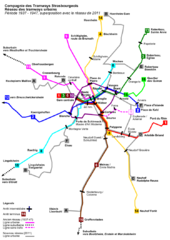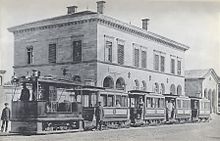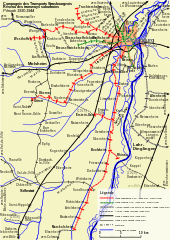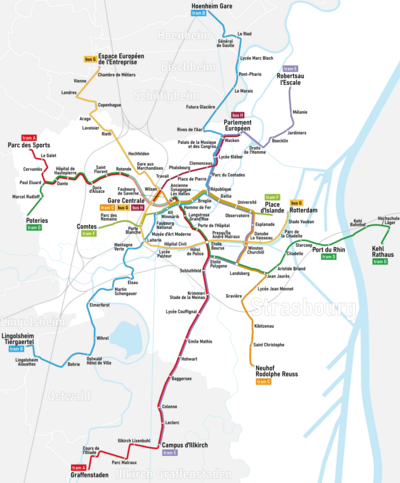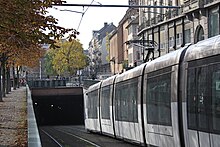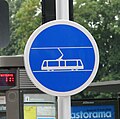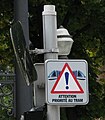Strasbourg tram
| Strasbourg tram | |
|---|---|
| Turf track along avenue de la Marseillaise | |
| Basic information | |
| Country | France ; Germany |
| city | Strasbourg |
| opening | November 25, 1994 |
| operator | CTS |
| Infrastructure | |
| Route length | 49.8 km |
| Gauge | 1435 mm ( standard gauge ) |
| Power system | 750 V = overhead line |
| Stops | 86 |
| Tunnel stations | 1 |
| Depots | 3 |
| business | |
| Lines | 6th |
| Line length | 70.8 km |
| Clock in the peak hours | 5 min |
| Cruising speed | 20 km / h |
| vehicles | 53 Bombardier Eurotram 41 Alstom Citadis 403 |
| Top speed | 60 km / h Citadis 403 65 km / h Eurotram |
| statistics | |
| Passengers | 457,000 per day (2018) |
The Strasbourg tram ( French Tramway de Strasbourg ) is an outstanding example of the tram renaissance in the 1990s. After a lengthy local political decision-making process, the French city of Strasbourg combined the reintroduction of the tram in 1994 with an urban redesign. The experience gained in Nantes (since 1985), Grenoble (since 1987) and Strasbourg contributed to the construction of new trams in other French cities such as Montpellier (2000) and Nice (2007). There are now six tram lines in the largest city in Alsace on a network of 48.1 kilometers. The operator is the Compagnie des transports strasbourgeois (CTS).
As early as 1894 to 1960, an electric tram was in service in Strasbourg, which arose from the horse-drawn tram that opened in 1878 . In addition to an extensive urban network, there were several overland routes. The decline of this tram operation began in the 1930s and ended in 1960 with the closure of the last lines.
Horse tram and tram from 1878 to 1960

Society
On April 5th, 1877, when Alsace belonged to Germany, the "Strasbourg Horse Railway Company" was founded.
On April 25, 1888, it changed its name to "Strasbourg Tram Company".
From May 14, 1897, the electrical company AEG was the main shareholder of the tram, in 1912 the city of Strasbourg acquired 51% of the share capital in order to better serve the interests of the population.
The Compagnie des Transports Strasbourgeois (CTS), which still exists today, emerged from this tram company.
City network
French period until 1870
Since 1848, horse-drawn buses and horse-drawn cabs had been used in Strasbourg's local public transport. The first two standard-gauge lines of the horse-drawn railway company opened in 1878 in quick succession. The first led to the Kehler Rheinbrücke , the second to Hönheim . Horses were used in the city center, while in the outskirts the trains were hauled by small steam locomotives. The Schweizerische Lokomotiv- und Maschinenfabrik (SLM) in Winterthur supplied the first horse-drawn railway systems.
German period 1871 to 1918
From 1871 to 1918, Strasbourg and Alsace belonged to Germany.
By 1885, additional routes were opened to the Königshofen , Robertsau and Neuhof districts and to Wolfisheim . During the same period, several routes were built in the city center, such as the " Centralbahnhof " opened in 1883 .
In 1886 the meter gauge was used for the first time when the line to Grafenstaden was being built . This route marked the end of the first expansion phase.
AEG received the order to electrify the horse-drawn tram on December 14, 1894. The electrical operation of three sections of the route was planned while maintaining the standard gauge. In May 1897, AEG, as the new main shareholder of the tram company, promised to re-gauge and electrify the entire city network. This was tantamount to rebuilding the network. This also affected the line to the Kehler Bridge: on March 14, 1896, the standard-gauge steam tram started operating. After the ship's bridge was replaced by a permanent bridge over the Rhine, in 1898 the connection over the Rhine was extended to meter gauge to Kehl and switched to electrical operation.
Even before 1900, gauging and electrification in the city network were completed. In 1900 and 1901 routes to the Kronenburg district and the suburbs of Lingolsheim and Breuschwickersheim went into operation. After the turn of the century, a circular route known as the "Rundbahn" was built in the city center. The tram network was expanded until 1913, when the First World War interrupted development.
French period from 1919
At the end of 1918 after the end of the war, Strasbourg and Alsace became part of France . The tram company was renamed “Compagnie des Tramways Strasbourgeois” (CTS). It was able to open two shorter new lines in 1919.
In 1923 Wacken was connected to the tram in the north of the city.
The last major new line was the route to Route de Brumath in Schiltigheim, opened in 1927 .
In 1930, a new main depot and a central workshop went into operation in the Cronenbourg district. After minor additions, the city network reached its greatest expansion in 1937 at 82.7 kilometers. The first bus line ran to Wingertheim in 1928. On May 27, 1939, the trolleybus was added as a means of urban transport.
Overland network
German time until 1918
In parallel to the city network, the Strasbourg tram company built a network of meter-gauge rural railways with a total length of 194 kilometers from 1886 to 1909 .
The overland network emerged from the tramway to Grafenstaden, which was laid out in meter gauge in 1886. On November 6, 1886, this line was extended to Markolsheim , 54 kilometers south of Strasbourg . There was a transition to the meter-gauge railway, also opened in 1886, to Colmar, 27 kilometers away . This route operated by the Reichseisenbahnen in Alsace-Lorraine offered a connection to the Colmar tram . From 1907 to 1914 there was a continuous narrow-gauge connection via Colmar to the tram in Mulhouse , just under a hundred kilometers south of Strasbourg.
Simultaneously with the Markolsheim route, a 2.5-kilometer branch route from the Boofzheim intermediate station to Rheinau went into operation in 1886 . In 1893 the local railway Rhein-Ettenheimmünster was opened on the opposite bank of the Rhine by the railway construction and operating company Vering & Waechter . The planned connection of the two routes failed due to the failure to build a bridge over the Rhine; The project was finally abandoned after the First World War , when the Rhine became the German-French border.
A second branch line opened up in April 1883 Erstein , which was only affected by the Markolsheimer line. The 5.5 kilometer long route ended at the Erstein Reichsbahnhof. The connection to the Erstein sugar factory was of particular importance . When, on November 21, 1907, the Deutsche Eisenbahn-Betriebsgesellschaft opened a small railway from Erstein via Oberehnheim to Ottrott , this company temporarily took over the operation of the Ersteiner Querbahn. The 19-kilometer route to Ottrott remained unprofitable as it only opened up a few villages. On the orders of the Supreme Army Command (OHL), the railway was dismantled shortly after the outbreak of the First World War for the extraction of track material.
In the north-west of Strasbourg there was a 15-kilometer connection to Truchtersheim from October 1, 1887 . On April 1, 1908, a 21-kilometer route to Westhofen was opened, which branched off from the Truchtersheimer Bahn in Dingsheim . In contrast to other overland railways, the Westhofener Bahn avoided the closed locations. It gained importance in excursion traffic, especially during the grape harvest in the growing area around Westhofen and Marlenheim .
From 1892, regional trams also opened up the Hanauerland region on the right bank of the Rhine around Kehl . On January 11, 1892, the line from Kehl via Schwarzach to Bühl was opened. On April 1, 1898, the route followed from Kehl via Altenheim to Ottenheim , where there was a connection to the Lahr tram . From July 15, 1898, this route was supplemented by a connection from the old people's home to Offenburg . In May 1901, the Strasbourg tram company agreed a joint operation with the Lahr tram. From then on there were continuous trains running from Ottenheim via Lahr to Seelbach in the Black Forest. In the north of the network, Schwarzach reached Rastatt , 60 kilometers from Strasbourg , on May 2, 1909 .
Within the Strasbourg urban area, the overland trains departed from two different train stations: the trains to Markolsheim started at the local station not far from the hospital gate, and the terminus for the trains to Truchtersheim and Westhofen was at the market hall on Hausberger Strasse. In the direction of Hanauerland the train departed from the Kehler secondary station. All overland routes were connected to one another after the city network had been re-tracked in 1898. This option was used in freight transport and for internal purposes such as trips to the main workshop in Gutleutstrasse. The overland network was mainly operated with steam locomotives; horses were used for the two short branches to Erstein and Rheinau.
In addition to passenger traffic, there was a brisk freight traffic. The transport of sugar beets to the Erstein sugar factory during the beet campaign in autumn was of particular importance on all routes . Rolling wagons were available for transporting standard-gauge freight wagons in the narrow-gauge network . There were transition options to the standard-gauge railway network in Neudorf in the south of Strasbourg, in Kehl, Bühl, Rastatt and Erstein and in Marlenheim on the Westhofener Bahn. Loading narrow-gauge freight wagons onto standard-gauge transport wagons was less common. It was used for transports to the Kehler harbor and for exchanging wagons between the various overland routes. Until 1960, open freight cars were used to transport rubbish from the city of Strasbourg to an area south of Graffenstaden.
French period from 1919
After Strasbourg became French at the end of 1918, the connection over the Rhine bridge to Kehl was interrupted. The network was divided into two almost equally large parts: 98.7 kilometers remained in the possession of the CTS, while 95.5 kilometers went to the Republic of Baden in 1922 , after the CTS had withdrawn the license for these routes in 1920 and the management was transferred to the Deutsche Reichsbahn had been given. In 1923 the Mittelbadische Eisenbahnen (MEG) took over the lines on the right bank of the Rhine. Until 1970 the MEG operated the passenger traffic on partial sections. Today there is still a line near Bühl, which has been converted to standard gauge and serves freight traffic. This is the connection Bühl – Schwarzach – Stollhofen, where it branched out to Söllingen and Greffern. It was converted to the standard gauge in the summer of 1972 and - partially re-routed - put back into operation for freight traffic. This small network of 15 km in length represents the SWEG operation in Schwarzach to this day. The basis for this was the operation of the NATO airport Söllingen, on whose premises the airport Karlsruhe / Baden-Baden (Baden-Airport) is located today, and the siding of the company Dow Chemical GmbH in Greffern .
On November 1, 1923, the Bas-Rhin department commissioned CTS to operate the Rosheim – Saint-Nabor railway line, which had been under French administration since 1919 and was opened in 1902 by the Berlin-based railway construction and operating company Vering & Waechter .
In Alsace, the Bas-Rhin department supported the CTS in modernizing the overland network. The entire route network was electrified in quick succession between May 1925 and August 1926. On February 2, 1926, the horse-drawn tram operation on the branch line to Rheinau, now Rhinau, came to an end.
On January 16, 1930, a new line from Ottrott to Strasbourg went into operation. From Ottrott to Meistratzheim, it used the route of the small railway, which was dismantled in 1915, then took the direct route to Strasbourg and found a connection to the city network in Lingolsheim. At the same time, a bus connection was set up from Ottrott to Mount Odile , which took into account the heavy pilgrimage to the mountain.
vehicles
|
Inventory of the vehicle fleet for the city network around 1908:
|
Around 1908, almost 150 railcars and a good 170 sidecars were available for city operations. Around 100 railcars came from a standard series supplied by the Cologne-based wagon factory Herbrand . As two-axle vehicles with 18 seats, they corresponded to the type of vehicle found in many cities at the time. Initially the platforms were open; Glazing began before 1914 to protect drivers from the elements. A series of railcars (No. 86-98) delivered by Herbrand in 1900 had two-part platforms at both ends that were closed from 1907 onwards. In 1908, the MAN plant in Nuremberg delivered 29 railcars that were equipped with more powerful engines.
The 173 sidecars existing in 1908 were divided into a larger number of types; quite a few sidecars had been built in the tram company's workshop. For the excursion traffic on Sundays, especially in the forests on the Rhine, 44 roofed but all-round open summer carriages were available. A further 41 summer cars had been converted for year-round operation before 1908 in order to take into account the increasing traffic to the suburbs.
The overland operation was contested with steam locomotives until 1925/26. A total of 53 steam locomotives were owned by the tram company, but never at the same time. A first series of 20 steam locomotives was still built for standard gauge by the Swiss Locomotive and Machine Factory in Winterthur, after the electrification of the city network it was re-gauged and put into overland operation. Later the Elsässische Maschinenbau-Gesellschaft in Grafenstaden was the main supplier of the tram company; Borsig built individual steam locomotives . These more powerful machines displaced the older steam locomotives into subordinate services, for example shunting at the local train stations in Strasbourg. In 1914, the passenger cars of the overland network were assigned to the routes on the left and right of the Rhine. At that time there were 55 third class cars and 29 second and third class cars. With one exception, they were two-axle vehicles; Suppliers included de Dietrich , the Rastatt wagon factory and the tram company's workshop.
|
Inventory of railcars for the city network at the end of the 1930s:
|
After the First World War, numerous older railcars were converted into sidecars. Deliveries by the companies De Dietrich (1931, 15 railcars) and Carel & Fouché (1937/38, 15 railcars) supplemented the stock of vehicles in the city network. 15 four-axle center entry cars from Franco-Belge increased the number of sidecars in 1927. After the electrification of the overland network, city carriages were initially used. Between 1929 and 1931 De Dietrich delivered 14 heavy four-axle railcars for overland operations. From 1926 onwards, several electric locomotives and luggage railcars replaced the steam locomotives in freight transport.
After the Second World War, there was no procurement of new vehicles, although the CTS management was open to this. At that time, no tram cars were produced in France; procurement abroad failed due to a lack of foreign currency.
Between 1907 and 1947 a post tram connected the main train station with the main post office in Hohenlohestrasse (Avenue de la Marseillaise) . There is still a tunnel of the former postal tram at the main train station. The postal administration owned three railcars; the drivers were employees of the post office. The railcars were kept in the same color as the mailboxes and changed color twice: first yellow in the time of the Reichspost , then the blue of the French Post and red in the time of the German occupation of Strasbourg in World War II. Combined luggage and mail trolleys ran on almost all routes in the overland network.
Decline of the tram
From 1930 onwards, the number of passengers on the tram decreased: in 1918 there were 46 million passengers, for which 144 motor vehicles and 173 sidecars were available. In 1930 54.6 million people were transported, by 1938 this number had fallen to 33 million. The reasons for this lay in the establishment of the bus routes and the emerging motor vehicle traffic. The lack of fuel in World War II initially prevented the planned conversion of the tram network to bus operation. On some overland routes, including to Truchtersheim and Westhoffen, buses had temporarily taken over operation at the end of the 1930s.
After the end of the war, the CTS lacked the necessary funds for thorough modernization, especially of the rolling stock. The war damage, the lack of maintenance during the war and the continued increase in individual traffic led to the decision to completely stop tram operations. By 1956, the entire overland network was converted to bus operation.
From 1957, two lines operated in the city network, for which modernized vehicles were available. The last day of operation of these two lines was April 30, 1960. On the following day, a vehicle parade took place, including a former CTS steam locomotive, which was last used as the factory locomotive of the Erstein sugar factory. The decommissioned trams were initially dismantled and later burned.
Following closure of the trolley bus -betriebs on 31 March 1962, the diesel bus was the only urban local transport. From 1968 almost 4 kilometers of bus lanes were created. In 1978 there were 229 buses available for the operation of twelve city lines, which were used by 39.6 million passengers per year. There were also 15 intercity routes with another 65 buses and 2.7 million passengers. The cruising speed in the city was given as 10 to 15 km / h.
The way to reintroduce the tram
The plans to reintroduce a tram in Strasbourg can be traced back to the 1970s. However, it was not until 1994 that the first line went into operation. The urban planning association, an amalgamation of Strasbourg and its surrounding communities, advocated the construction of a modern tram in December 1976. The choice of the transport system was controversial: A metro and a light rail system , as they were being implemented in many West German cities at the time , were up for discussion . Proponents of a tram referred to the operation in Basel , which has twice as many passengers for a comparable city size. The city council under Mayor Pierre Pflimlin decided on November 26, 1979 to build a light rail. Two routes were planned that would start in the south - in Illkirch-Graffenstaden and Neuhof - and merge into a main route at the Place de l'Étoile station. The main line was to cross the city center largely underground. The plan was to build a 1,300-meter-long tunnel with three stations including the Gare Centrale terminus. The full opening of the plant was planned for July 1986.
The replacement of Pflimlin as mayor by Marcel Rudloff after the local elections in 1983 prevented the realization of the plans. Rudloff, like Pflimlin from the bourgeois camp, was a proponent of the Véhicule automatique léger (VAL), an automatically operated small-profile metro. The city council and part of the surrounding communities approved of Rudloff's plans. After new plans had been drawn up, a contract was signed with the VAL manufacturer Matra in 1987 . The decision between VAL and trams was the main topic of the local elections in 1989. In the newly elected city council, the left dominated under Mayor Catherine Trautmann , who advocated the tram. In December 1989 the city parliament passed the fundamental decision for the construction of the tram. In November 1990, the municipal transport company CTS received the order for the realization and later operation of the tram. The public benefit of the tram project was certified on June 17, 1991, and construction began that same month. At the same time, public orders were given to well-known international artists such as Mario Merz , Barbara Kruger and Jonathan Borofsky to design the stations and routes.
The tram from 1994
Line network
The following tram lines are currently in operation (as of August 2020):
| line | Line course | Length (in km) | Stops | Opened |
|---|---|---|---|---|
| A. | Parc des Sports - Dante - Rotonde - Gare Centrale - Ancienne Synagogue - Les Halles - Homme de Fer - Langstross - Grand'Rue - Étoile Bourse - Krimmeri Stade de la Meinau - Baggersee - Colonne - Leclerc - Campus d'Illkirch - Illkirch Lixenbuhl - Parc Malraux - Cours de l'Illiade - Graffenstaden | 14.7 | 27 | 1994 2013 2016 |
| B. | Hœnheim Gare - Pont Phario - Wacken - République - Homme de Fer - Alt Winmärik - Montagne Verte - Elsau - Ostwald Hôtel de Ville - Lingolsheim Alouettes - Lingolsheim Tiergaertel | 14.8 | 27 | 2000 2008 |
| C. | Gare Centrale - Homme de Fer - République - Université - Observatoire - Landsberg - Kibitzenau - Neuhof Rodolphe Reuss | 8.1 | 17th | 2000 2007 2010 |
| D. | Poteries - Marcel Rudloff - Paul Éluard - Dante - Hôpital de Hautepierre - Ducs d'Alsace - Saint-Florent - Rotonde - Gare Centrale - Ancienne Synagogue – Les Halles - Homme de Fer - Langstross – Grand'Rue - Étoile Bourse - Étoile Polygone - Landsberg - Aristide Briand - Citadelle -Port du Rhin - Kehl train station - University / Läger - Kehl town hall | 12.6 | 21st | 1998 2013 2017 2018 |
| E. | Robertsau L'Escale - Mélanie - Jardiniers - Robertsau Boecklin - Parlement Européen - Wacken - République - Université - Observatoire - Landsberg - Étoile Polygone - Krimmeri Stade de la Meinau - Baggersee - Colonne - Leclerc - Campus d'Illkirch | 13.6 | 26th | 2007 2019 |
| F. | Place d'Islande - Observatoire - Université - République - Homme de Fer - Alt Winmärik - Faubourg National - Porte Blanche - Parc des Romains - Comtes | 7.32 | 16 | 2010 2020 |
Route network
The construction of today's standard-gauge tram network took place in the following steps:
Trunk lines (from 1994 to 2000)
Line A was opened on November 25, 1994 over a length of 9.8 kilometers between the residential area of Hautepierre in the west and the quarry pond in the south. To cross the tracks of the main train station and other traffic routes, a 1400 meter long shield tunnel was built between Rotonde and Les Halles . The Gare Centrale station is located in the tunnel 17 meters below the station forecourt. On July 4, 1998, this line was extended at the southern end by 2.8 kilometers to Illkirch Lixenbuhl. On August 31 of the same year, the D line between Rotonde and Étoile Polygone was opened. Line D initially used the stretch of line A to a large extent and served the function of an amplifier line in the inner city area.
Extensions
On September 1, 2000, the second main line went into operation with the new lines B and C with a total length of 11.9 kilometers. From the common end point in the Elsau development area , the city center is crossed from southwest to northeast. You can change to lines A and D at Homme de Fer station. At Place de la République, line C branches off to the Esplanade terminus and opens up the university district . Line B turns north, connects the exhibition grounds at Wacken, crosses the independent communities of Schiltigheim and Bischheim and ends in Hœnheim . At the terminus there has been a transfer option to local transport on the Strasbourg – Lauterbourg railway line since September 2002 . An extension to " Ganzau " as a TramTrain is planned.
On August 25, 2007, line D was extended by 1.8 kilometers from the “Étoile Polygone” station to the new “Aristide Briand” terminus. On the same day, the Neuhof district was connected to the tram network: Line C from Esplanade station was extended by 4.2 kilometers for this purpose. Both lines have a common section of 600 meters between the stations “Landsberg” and “Jean Jaurès”. This created a second north-south connection that bypasses the city center to the east. On this connection, the tangential line E runs between Wacken and the quarry pond; It is hoped that it will relieve the “Homme de Fer” junction in the city center. On November 23, 2007, this line was extended from Wacken by 2.5 kilometers to Robertsau. The Europaviertel was thus connected to the tram network and the European Parliament located here received its own stop. On May 23, 2008, line B was extended by 4.9 kilometers from Elsau via Ostwald to Lingolsheim.
On November 27, 2010, the new line F went into operation, which runs between the “Elsau” stop and a newly created stop at Place d'Islande east of the “Observatoire” stop (“Vauban”). An extension towards “Port du Rhin” is being considered. At the same time, line C received a new route; it now ends at the newly created above-ground stop at the Strasbourg train station (“Place de la Gare”), which is not connected to the “Gare Centrale” stop in the tunnel. A total of 1.5 kilometers of additional routes and three additional stops went into operation.
On November 30, 2013, new sections of line A (1 km; two new stops: “Le Galet” and “Parc des Sports”; renaming of the stop “Hautepierre Maillon” to “Cervantès”) and line D (also 1 km ; three new stops: "Paul Éluard", "Marcel Rudloff" and "Poteries") inaugurated in the west. At the same time, the first Metrobus ( bus à haut niveau de service ) between the main train station and the “Espace Européen de l'Entreprise” stop in Schiltigheim was opened with Line G.
On April 23, 2016, line A in the south was again extended by a further three stops, which now serves the center of Illkirch-Graffenstaden. As a result of these successive extensions, Line A has the same number of stops and practically the same length as Line B. On the same day, Line E was also extended by three stops to “Campus d'Illkirch”, where the trains branch off in a double-track sweeping system on rue de l'Industrie. (A possible extension?)
On June 17, 2019, line E, which opened in 2007, was extended by three stations and 1.6 kilometers further into the Robertsau district to “ Robertsau L'Escale ”. The new route of Line F has also been used since August 31, 2020 (extension by three stations and 1.7 km).
Since February 24th, the Metrobus line H has been running between " Gare Centrale " and " Parlament européen " via the Boulevards and " Wacken "
Cross-border route to Kehl
The first tram connection from Strasbourg to Kehl was opened in 1898. It existed until shortly after the end of the First World War, when Kehl became a border town to France again. During the Second World War, the tram connection was resumed briefly.
On February 13, 2009, the council of the Strasbourg City Council decided to extend Line D eastwards to the Port du Rhin district and then over the new Beatus-Rhenanus Bridge over the Rhine to Kehl station . The construction work for this began in early 2014, and the line went into operation on April 29, 2017. Since November 23, 2018, the route has continued to Kehl Town Hall.
Only on the section within Kehl is free travel with the German severely handicapped ID card.
Traffic conception and design
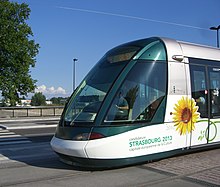

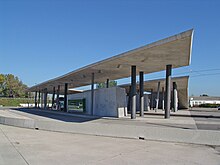

The tram project was not only intended to solve the urban traffic problems, but was seen as an opportunity for a comprehensive redesign of the city. Similar approaches had already been followed with the tramway in Grenoble , which opened in 1987 . The construction of tram lines in the old town of Strasbourg was the reason to cut through traffic in the city center. The city center was divided into four areas, which can now be accessed via loop-like streets. The central Place Kléber , previously frequented by 50,000 vehicles per day, has been converted into a pedestrian zone . The number of parking spaces in the city center has been significantly reduced; as a replacement, large park-and-ride areas were created in the outskirts. 530 parking spaces are available at the Baggersee stop, 800 in Elsau and 750 in Hœnheim Gare. Bus traffic has been removed from the city center and instead used as feeder lines to the tram network: important transfer stations are “Baggersee”, “Montagne Verte” on the route to Elsau and “Rotonde” west of the main train station. While nine bus routes ran through the city center before 2000, this number has been reduced to two after the opening of the second main route.
Design issues were of particular importance. For this purpose, an architect was appointed who was responsible for the integration of the tram from the point of view of urban design. The number of lanes for motor vehicle traffic was reduced on many main roads in order to make room for the tram route. In the university district, for example, before the tram was built, the Boulevard de la Victoire was a four-lane street, whose tree-lined median served as a parking lot. With the construction of the tram, the median was converted into a pedestrian and cycle path. The street has been reduced to two lanes in favor of the tram. At the “Universités” and “Observatoire” stops, you get off on the left to the footpath.
Such design measures were not only carried out in the city center, but also in the outskirts. In Hautepierre, a residential area created in the 1970s, the tram runs along the honeycomb-shaped street. The width of the tramway has been reduced in favor of the tram and pedestrians. The terminus “Hœnheim Gare” and the adjacent park-and-ride area , designed by the architect Zaha Hadid , received the Mies van der Rohe Award for European Architecture in 2003. Over a third of the route network, especially in the suburbs, is turf track.
The stops are uniformly marked with round columns, designed by the designer Jean-Michel Wilmotte , which serve to provide passenger information. Along lines A and D, these are also provided with texts from the literary-anarchic movement OuLiPo (Ouvroir de Littérature potentialielle) . The texts consist of imaginary linguistic interpretations of the respective station names, sound variations on the expression Le tramway de Strasbourg and a history cycle , the respective sequences of which only ever use the letters of the respective stop name. There is also a comic strip by the draftsman and installation artist Alain Séchas .
The platforms are around 45 meters long and have access ramps. The platforms on lines A and D are 245 millimeters high and thus 60 millimeters lower than the floor of the car. In order to enable barrier-free access, the stations have meanwhile been provided with platforms at the level of the stopping position of the first car door. The platforms built later were given a height of 305 millimeters throughout. The announcement of the stop in the vehicles is introduced by sound collages that differ depending on the station. These were designed by the concept musician and former philosophy student Rodolphe Burger .
vehicles
Today the vehicle fleet consists of 103 low-floor articulated multiple units , including 40 Bombardier Eurotram 41 Alstom Citadis 403 and 22 Alsthom Citadis 403 NG.
A new type of vehicle was designed for the opening of the tram in 1994. The objectives were the complete low-floor design of the vehicle and - in accordance with the importance of the design - an individual design. Eurotram was created in cooperation between the Italian company Socimi and the municipal transport company CTS . The front section is striking with a large, curved, one-piece pane. In line with the idea of a “rolling walkway”, the windows in the passenger area are also exceptionally large. The Eurotram has a modular structure. Between the head modules with the driver's cab there are alternating floating main car parts and short articulated modules with a carriage. The entrances are in the drive-free car parts.
For the opening of Line A, a total of 26 eight-axle Eurotram articulated wagons were procured in 1994 and 1995. These cars are 33.1 meters long and can carry 210 passengers. For the second expansion stage of the network, the CTS ordered additional vehicles between 1998 and 2000: Socimi supplied another 10 eight-axle and 17 ten-axle articulated multiple units. The ten-axle vehicles, also known as “Jumbotram”, are 43.05 meters long and offer space for 270 passengers. The vehicles proved themselves in operation, but details met with criticism: The wide, one-piece doors, for example, require long opening and closing times and thus extend the stopping times. The generous glazing allows sunlight to heat up the driver's cab.
The construction of the trams was taken over by the consortium partner ABB after the bankruptcy of Socimi ; After various company takeovers and mergers, Eurotram was offered by Bombardier Transportation . For cost reasons - a »Eurotram« car was around a third more expensive than comparable vehicles - on July 15, 2003, CTS placed the order for the third delivery of vehicles to Alstom . 35 seven-part Citadis 403 trams were ordered , and the contracting parties agreed an option for an additional twelve cars. As of 2005, Alstom delivered 41 ten-axle vehicles with a length of 45.06 meters and a capacity of 288 passengers. The front section of the Citadis trains was modeled on that of Eurotram. A Citadis 403NG series with a modified head shape was delivered from 2016 to 2018. The 22 units are also approved in Germany. An option for 17 more units was exercised in March 2020, also to replace the three-part Eurotram, which no longer cope with the traffic volume.
business
All lines operate Monday through Saturday from 4:30 a.m. to 0:30 a.m. On Sundays and public holidays, operations start at 5:30 a.m. Between 6:30 a.m. and 8:00 p.m., the service runs every five to six minutes, at other times every quarter of an hour. On the routes in the city center, which are occupied by two lines, train schedules between two and three minutes occur during the day.
Line A reaches a cruising speed of 23 km / h, line B of 20 km / h. Lines C and D, which ran mainly in the city center before 2007, had a cruising speed of 18 km / h. The distances between stops lie between 600 meters at the line A, and 480 meters at the line C. In light systems have trams generally priority .
Depots
The Cronenbourg depot was reactivated for Line A, which was opened in 1994 . It was built in 1930 for what was then the meter-gauge tram company and served as a bus depot from 1960 onwards. 45 trams can be parked in Cronenbourg; the central workshop with a total of ten tracks is also located here. The depot is connected to the Rotonde stop at the western end of the station tunnel via a longer operating route. He is responsible for trains on lines A and D.
The trains on lines B and F are parked in a second depot at the Elsau stop. Elsau has a storage hall with six tracks and a workshop with three tracks. A third depot was built on the route to Neuhof, which opened in 2007, at the Kibitzenau station for lines C and E. All three depots are also used for bus operations.
Balance sheet
Up to 2000, 477 million euros had been invested in the construction of the route network. In September 2002, the third expansion phase was expected to cost EUR 304 million. This is around 23.5 million euros per kilometer, a high value compared to Germany, which is explained by the importance of the design. The order placed in 2003 for 35 Citadis articulated multiple units had a volume of 98.3 million euros, the Eurotrams previously procured cost a total of 118 million euros. The most important financing instrument is the versement transport , a transport tax levied by all employers with more than nine employees. Strasbourg uses the maximum allowable rate of 1.75% based on the wage bill.
In 1996, 17.9 million passengers used the tram, in 1999 it was 20.7 million. After the commissioning of further lines, 39.9 million passengers were recorded in 2001 and 63.1 million in 2010. In 2003, the daily number of passengers on lines A and D was 96,400, and on lines B and C 108,000. These figures were well above the planning assumptions of 75,000 and 80,000 passengers, respectively. From 1990 to 1995, the number of car journeys in the city center decreased by 17%. 65% of those working in the city center use the tram to get to work. In surveys, 92% of the population said they were satisfied with the tram.
The reintroduction of the Strasbourg tram is seen as a success that led to the construction of new trams in other French cities such as Lyon , Orléans and Montpellier : In Strasbourg, as “before in Grenoble [...], the tram was built as part of an overall project to revitalize the city center and the City beautification seen. Nowhere before have these planning maxims, the tram as a total work of art, been implemented as consistently as here. The success, in terms of traffic as well as economic and urban design, proved the planning guide right. "
Further expansion
- The current concept for Line F was created in 2004; Previously, the construction of a tram-train link-free link between rail and tram traffic at the main station was planned. For this purpose, the existing tunnel of the old postal tram should be used and a continuous connection from the tram network to the railway line to Molsheim should be built. From Molsheim the trains should continue to Gresswiller or via Obernai to Barr . In 2004 it was decided not to build a connection free of transfers. The railway line to Molsheim was expanded for local traffic by December 14, 2008 by setting up additional stops, in particular the Entzheim train station was moved so that the Strasbourg airport there is better connected to the railway network. A connection free of transfers in line with the tram-train concept is only to be created in a later, second phase.
- On April 30, 2009, French Environment Minister Jean-Louis Borloo agreed to help finance an extension of Line A from Hautepierre to the Koenigshoffen district and the municipality of Oberhausbergen . The 4.8 km long route is also intended to connect the “Zénith” venue to the tram network; a first construction phase was opened on November 30, 2013. On April 23, 2016, line A in the south was extended by 1.8 kilometers to the center of Illkirch-Graffenstaden . At the same time, line E was also extended to “Campus d'Illkirch”.
- Line E was extended by three stops in the north to the center of the Robertsau district . This extension went into operation on June 17, 2019. The construction costs amounted to 19.4 million euros.
In 2016, the expansion of the tram network was described as "largely completed". Only smaller extensions should be added.
In January 2017, work began at the “Faubourg National” stop for the new line to Koenigshoffen, which will open in September 2020. On the 1762 meter long line are the three stops "Porte Blanche", "Parc des Romains" and "Comtes". There are two single-track sections. An extension to "Potteries" is planned in a further phase. It will serve line F. The first test drives began on June 8, 2020. Elsau will lose its second line. In the meantime, the new timetables have been published on the website www.cts-strasbourg.eu, which are valid from August 24, 2020. After that, the new route will now be used by the new line F. Due to track construction work in the "Faubourg National" area, this timetable will not apply until August 29, 2020.
gallery
literature
- Erhard Born (arr.): Narrow gauge between the Vosges and the Black Forest . K. Seidel self-published, Schwäbisch Gmünd 1972, ISBN 3-9800014-0-7
- Gilbert Haslauer, Albert Herrenschneider: Strasbourg, the story of a tram . In: Straßenbahn Magazin , issue 17, August 1975.
- Georges Muller: L'Année du Tram . Les Editions Ronald Hirlé, Strasbourg 1994, ISBN 2-910048-15-2 (French)
- Christoph Groneck: New trams in France. The return of an urban mode of transport . EK-Verlag, Freiburg 2003, ISBN 3-88255-844-X
- Christoph Groneck: French planning models for tram systems compared to Germany . Dissertation, Bergische Universität Wuppertal, Wuppertal 2007 ( digital version , PDF file, 5.1 MB)
- François Laisney: Atlas du Tramway dans les villes françaises . Éditions Recherches, Paris 2011, ISBN 978-2-86222-067-3 , pp. 356–379 (French, from the perspective of architecture and urban development).
Web links
Historical views
- www.strasbourg-tramway.fr Views around 1900 , around 1930 , around 1955 and the year of closure, 1960
Current situation
- www.cts-strasbourg.fr Compagnie des transports strasbourgeois (CTS), the municipal transport company (French, English, German)
- www.trams-in-france.net Pictures and information about the Strasbourg tram (English)
- www.photo-alsace.com Contemporary views of the Strasbourg tram
Individual evidence
- ↑ ALSTOM fournira des tramways pour les extensions des lignes du réseau Strasbourgeois on alstom.com (French)
- ↑ FLEXITY Outlook - Strasbourg, France on bombardier.com (French)
- ↑ Résultats 2018 de la CTS on cts-strasbourg.eu
- ↑ L'Histoire du Tramway Urbain (French)
- ↑ On the history of the tram: Born: Schmalspur , passim. Furthermore Groneck: Tramways , p. 66 and Eckehard Frenz: The urban railway project of Strasbourg . In: Der Stadtverkehr , issue 4/1980, pp. 155–158
- ^ Kurt Seidel: The Strasbourg tram - Compagnie des Tramways Strasbourgeois . In: Born, Schmalspur , pp. 25–54
- ↑ to the routes in Alsace: Seidel: Tram , p. 30ff; also Hans Kobschätzky: route atlas of the German railways 1835-1892 . Alba, Düsseldorf 1971, p. 49f. and Hans Kobschätzky: Route Atlas of the German Railways 1893-1935 . Alba, Düsseldorf 1975, ISBN 3-87094-028-X , p. 27
- ^ To the network on the right bank of the Rhine: Hans-Dieter Menges, Claude Jeanmaire: Mittelbadische Eisenbahnen. From the Strasbourg and Lahr trams to the Mittelbadische Eisenbahn AG . Villigen 1974, ISBN 3-85649-014-0
- ↑ Haslauer, Herrenschneider: Strasbourg , p. 192
- ↑ Inventaire du matériel roulant au début du XXème siècle (French)
- ↑ L'HISTOIRE DE LA VILLE DE REICHSHOFFEN: L'industrie ferroviaire et automobile (French)
- ^ Haslauer, Herrenschneider: Strasbourg , p. 172ff.
- ^ Haslauer, Herrenschneider: Strasbourg , p. 184ff.
- ↑ Inventaire du matériel roulant en 1937 ( Memento of November 12, 2008 in the Internet Archive ) (French)
- ^ Haslauer, Herrenschneider: Strasbourg , p. 199ff.
- ^ Picture of sidecar 224 at the Amtuir Transport Museum
- ↑ Picture of the railcar 500 at the Amtuir Transport Museum
- ↑ Haslauer, Herrenschneider: Strasbourg , p. 230.
- ^ Günter Köhler: Post and Tram. Mail transport with trams in Germany and abroad. Konkordia-Verlag, Bühl 1998, ISBN 3-7826-0156-4 , pp. 88 ff., 313.
- ↑ Figures from Groneck: Tramways , p. 66.
- ↑ Haslauer, Herrenschneider: Strasbourg , p. 224
- ↑ Haslauer, Herrenschneider: Strasbourg , p. 235
- ↑ Figures for 1978 from Frenz: Stadtbahn-System , p. 158
- ↑ On planning history in general: Groneck: Straßenbahnen , p. 66ff, Groneck, Planungsleitbilder , p. 184f. The planning status at the end of 1979 at Frenz: Stadtbahn-System , p. 156ff.
- ↑ déclaration d'utilité publique (DUP). The DUP is comparable to the planning approval decision under German planning law. For this: Groneck: Planungsleitbilder , p. 20 f.
- ↑ List of works of art along lines A and B at www.planum.net (English)
- ↑ Groneck: Tramways , pp. 68, 70ff. Daniel Riechers: Renaissance of the tram in Strasbourg . In: Stadtverkehr , issue 2/1995, pp. 26/27
- ↑ Groneck: Tramways , pp. 68, 71ff. Stefan Göbel: Strasbourg doubles the tram system . In: Stadtverkehr , issue 10/2000, p. 50
- ^ Groneck: Tramways , p. 78; Daniel Riechers: New vehicles and routes: Strasbourg expands the tram . In: Stadtverkehr , Issue 9/2003, pp. 41–43. Information on commissioning at www.trams-in-france.net (English)
- ↑ Angelika Sadlau, Helmut Schneider, Carl Helmut Steckner: The Long Bruck: 600 years of ways to neighbors . Kehl 1989, pp. 98-100.
- ↑ Le tramway de Strasbourg pourra franchir la frontière ( Memento of December 5, 2013 in the Internet Archive ) (French)
- ^ Extension de la Ligne D. In: strasbourg-tramway.fr. Retrieved July 21, 2017 (French).
- ↑ Tariff Association Ortenau - Public Transport Info. Retrieved February 21, 2019 .
- ↑ Groneck: Planungsleitbilder , pp. 101, 184f.
- ↑ Groneck: Tramways , p. 64, 70ff; Groneck: Planning Concepts, p. 184ff.
- ↑ Groneck: Tramways , p. 73f.
- ↑ www.oulipo.net
- ^ Oulipo in Strasbourg ( Memento of September 12, 2007 in the Internet Archive )
- ^ The art program for the Strasbourg tramway ( Memento of October 22, 2007 in the Internet Archive )
- ↑ Les voix du tram
- ↑ Groneck: Planungsleitbilder , p. 202ff; Groneck: Tramways , p. 75ff.
- ↑ "Trottoir Roulant" see Groneck: Planungsleitbilder , p. 70
- ↑ a b (fr) Fiche technique: Tramway EUROTRAM de Strasbourg
- ^ Riechers: Vehicles , p. 41f .; Groneck: Planning Concepts, p. 205ff.
- ↑ (fr) Fiche technique: Tramway CITADIS de Strasbourg
- ↑ Information on the theoretical timetables of the urban route network. Compagnie des transports strasbourgeois (CTS)
- ↑ This information is based on the state before the opening of the third operating stage in 2007 at Groneck: Planungsleitbilder , p. 96. See also Groneck: Straßenbahnen , p. 74f.
- ↑ Groneck: trams 77. Location of the depots Cronenbourg 48 ° 35 '39 " N , 7 ° 44' 9" O , Elsau 48 ° 34 '8 " N , 7 ° 43' 21" O and Kibitzenau 48 ° 33 24 ' N , 7 ° 46' 16 " E
- ↑ The costs compiled according to the information in Groneck: Planungsleitbilder , pp. 94, 204; Riechers: Vehicles , p. 41f. Groneck, Planungsleitbilder , p. 95, gives the following costs per kilometer for Germany: city center 15 million euros / km, suburbs 10 million euros / km and new development areas 5 million euros / km.
- ↑ Groneck: Planungsleitbilder , p. 19
- ↑ Groneck: Planungsleitbilder , p. 111f. See also Groneck: Tramways , p. 64f.
- ^ Christoph Groneck: High quality public transport in France . In: Stadtverkehr , issue 12/2012, pp. 46–49, here p. 48
- ↑ Groneck: Planungsleitbilder , p. 40
- ↑ Stefan Göbel: Strasbourg plans Tram-Train . In: Stadtverkehr , issue 5/2006, pp. 30/31. Older planning status at Groneck: Tramways , p. 78
- ↑ L'Aéroport d'Entzheim à moins de 10 mn de la gare de Strasbourg (French)
- ^ Stefan Göbel: France promotes local transport projects. In: Stadtverkehr , issue 6/2009, pp. 42–46
- ^ Christoph Groneck: High quality public transport in France . In: Stadtverkehr , Heft 1–2 / 2013, pp. 48–50, here p. 48

